Are you suffering from a blocked nose and a bad bout of cold that just refuses to go away? Get yourself checked, for you may be having nasal polyps.
What are Nasal Polyps?
Page Contents
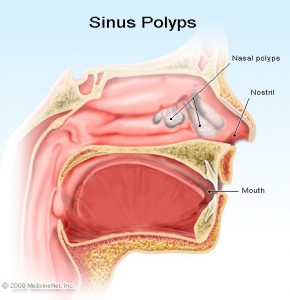 Picture 1 – Nasal Polyps
Picture 1 – Nasal Polyps
Source – medicinenet
Nasal Polyps are polyps in nasal cavity. These are fleshy growths that arise from the small cavities (sinuses) or the lining of the nose. Initially, these are not larger than small drops of water. But in some cases they grow as large as small grapes. These are not to be confused with tumors. These are non-cancerous overgrowths of the mucous membrane. Polyps are of different sizes and are generally yellow, pink or grey in color. In the US alone, nasal polyps are present in 5% non-allergic people and around 2% patients with allergic rhinitis.
The condition of having polyps or inflammation in the nasal cavity is known as Nasal Polyposis.
Causes of Nasal Polyps
The exact cause of nasal polyps is not known. It is widely supposed that these are caused by allergy. Cystic fibrosis, or thick mucus accumulation in the lungs and pancreas, is also sometimes believed to give rise to these outgrowths. However, it is also observed in a large number of people without any noticeable respiratory or allergic disorder. Asthma is also thought to be a cause behind this syndrome.
There are many other respiratory and allergic diseases that are also believed to result in the formation of polyps. These include ailments like Chronic rhinosinusitis, Kartagener’s syndrome, Young’s syndrome and Nasal mastocytosis. Aspirin intolerance is also thought to give rise to polyps.
Nasal Polyp Symptoms
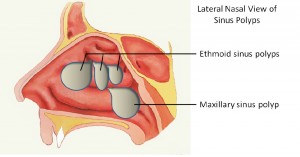 Picture 2 – Nasal Polyps Picture
Picture 2 – Nasal Polyps Picture
Source – nycfacemd
In patients with nasal polyps symptoms are mostly external and visible. Some of the common symptoms of nasal polyps are :
Blocked Nose
It is the main symptom of this condition. Patients feel their nasal passage is blocked. They find it difficult to breathe through the nose properly and end up breathing mainly through the mouth.
Sleep Apnea
It is the direct result of having a blocked nose. Difficulty in breathing can cause sleep apnea or respiratory difficulties during sleep. Large polyps in the nose cause sleep disturbances, especially during midnight.
Sinusitis
One of the paranasal sinuses can swell for a few days.
Anosmia
The sense of smell in nasal polyp patients is often impaired. In some cases, sufferers may have a total inability to smell.
Loss of Taste Sensation
Sufferers often complain of a loss of sense of taste.
Sinus Infections
Nasal polyps can also give rise to many other sinus infections that can cause breathing difficulties for the sufferer.
Rhinorrhoea
Watery discharge from the nose is common in polyp patients. Most people with nasal polyps experience watering of nose during any season. This may aggravate in dusty or polluted atmosphere.
Postnasal Drip
In patients with large polyps, the mucus comes down from the back of the nose. This leads to a very uncomfortable sensation of something constantly running down the back of the throat.
Headaches
The blocked nose may lead to accumulation of mucus and cause headaches in the sufferer.
Snoring
The nose blockage disrupts normal breathing and can cause snoring. This is an indication of respiratory difficulties.
Enlargement of Face and Nose
If polyps are left untreated, they can become very large. The face and nose can swell because of this. In very rare cases, large polyps can change the face structure and lead to double vision.
Altered Voice
The blocked nose and mucus accumulation can also lead to a change in voice quality. The vocal sound may get gruff and the speech can become very difficult to understand.
Itchiness
The patient may suffer from itchiness in the area around the eyes.
Facial Pain
If the polyps grow too large, the sufferer may experience pain in the face.
Nasal Polyps Treatment
The Nasal Polyp Treatment consists of either a reduction or a complete Nasal Polyp removal. The medicines that are commonly used for nasal polyp cure include :
Nasal Sprays
Doctors normally advise sprays like Beclometasone, Fluticasone, Flunisolide and Budesonide. These sprays can be bought even without a prescription but patients are advised to use these medicines only after correct diagnosis and expert recommendation.
Nasal Drops
Nose drops containing steroid medicines are used to reduce swelling in the nose. Regular use of these drops reduces the blockage of the nose and shrinks the polyps. Patients are normally advised to use these nasal drops for at least 4 to 6 weeks. Improvements are seen after one or two weeks. Fluticasone and Betamethasone are two steroid nasal drops that are commonly prescribed for polyp treatment.
Tablets
In some cases, steroid tablets like Prednisolone are prescribed for shrinking the polyps or reducing inflammation in the nose. When combined with nasal sprays or drops, it yields good results. A course of steroid tablets are prescribed as a temporary, emergency measure when the symptoms are very severe.
Nasal Polyp Surgery
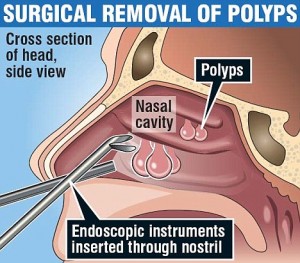 Picture 3 – Nasal Polyp Surgery
Picture 3 – Nasal Polyp Surgery
Source – dailymail.co.uk
In some cases, removing nasal polyps requires surgery. Nasal Polyp operation is not generally advised by doctors. It is kept as a last resort if there is a tumor, the polyps grow too large or if all other medications fail to reduce the polyps. Nasal polyp surgery is of two types.
Polypectomy (Nasal Polyps Surgery)
It involves using a local anesthetic on a patient and surgically removing the polyps while they are awake. If there are multiple polyps or the polyp size is too large, a general anesthetic is used before operation.
Endoscopic Sinus Surgery (Nasal Polyps Surgery)
In this process, a general anesthetic is used to remove polyps that are either very large or blocking the sinuses. The surgeon uses an endoscope to see the condition of the sinuses and perform an accurate operation.
Unfortunately, surgery is not a full-proof cure for nasal polyps. In one third sufferers, polyps grow back again and cause problems until they are again operated upon. Moreover, if the surgery is not done properly there can be bleeding from the nose.
Nasal Polyps Pictures
Nasal Polyp is an internal problem that is very difficult to understand for people despite the external symptoms. Here are some Nasal Polyps Photos that will help you know how a polyp looks like and how it creates breathing problems in sufferers.
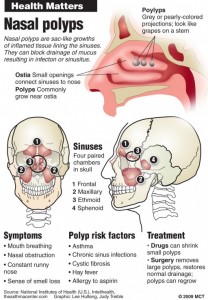 Picture 4 – Picture of Nasal Polyp
Picture 4 – Picture of Nasal Polyp
Source – dailyme
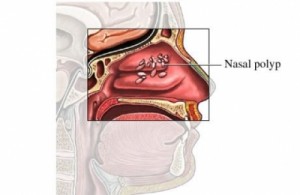 Picture 5 – Nasal Polyps Photo
Picture 5 – Nasal Polyps Photo
Source – butler
Nasal Polyposis is a curable disease. Like all diseases, it is better if it is treated early in life. In most cases, the disorder may not be life threatening. But it can affect the quality of a person’s life and impair his or her daily activities. It can let the person develop other allergies and sinus infections. In worse cases, it can even destroy the nasal or even the facial bones of a person. So if you have someone with Nasal Polyposis in your family, start the treatment immediately to avoid complications in the future.
